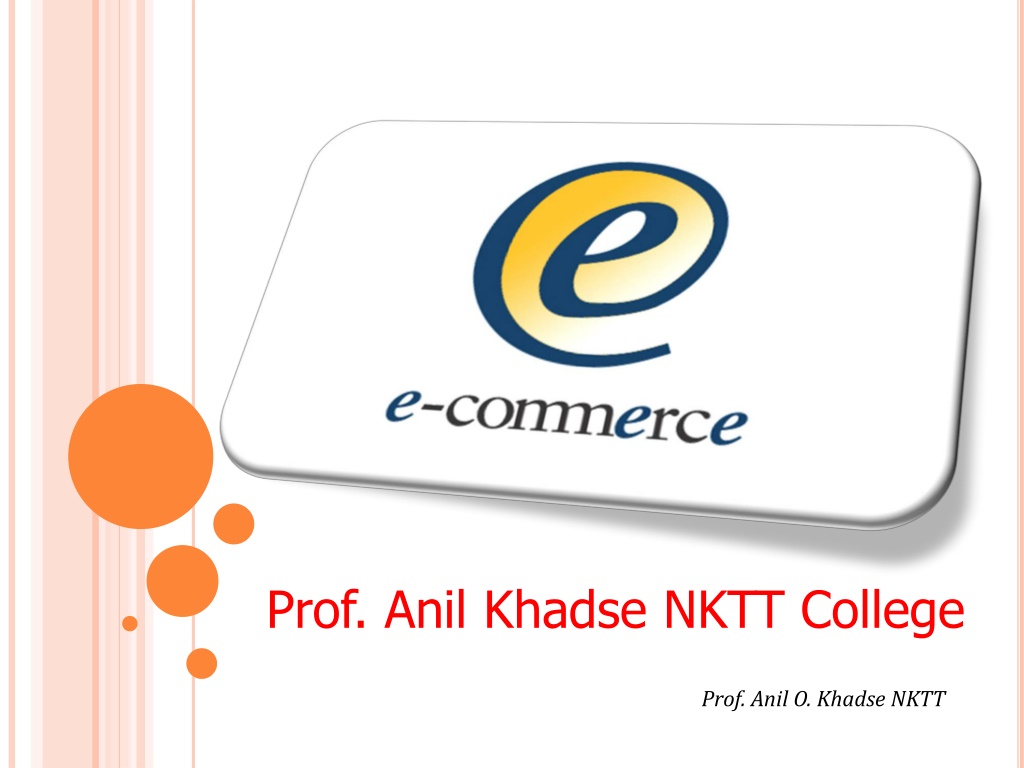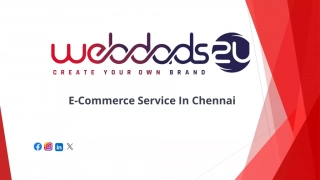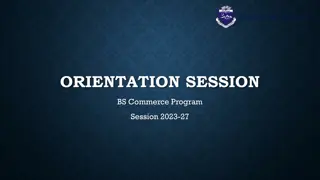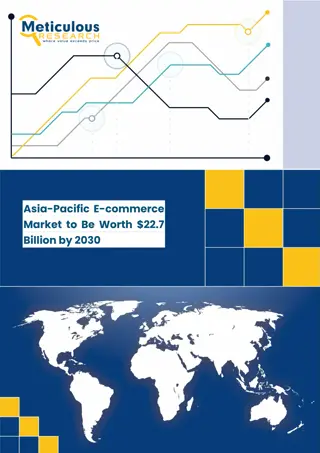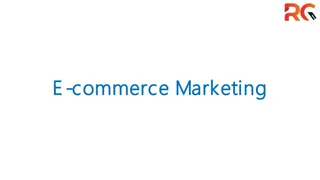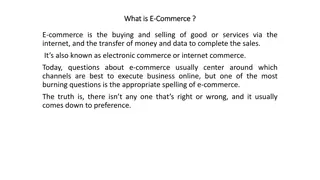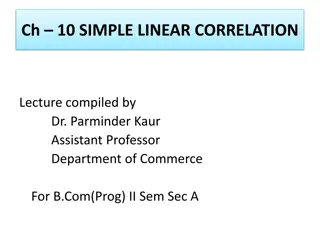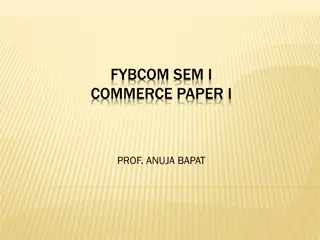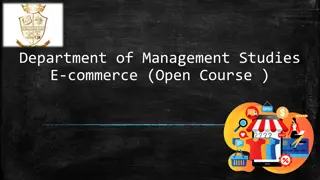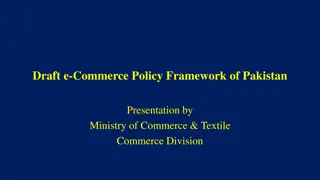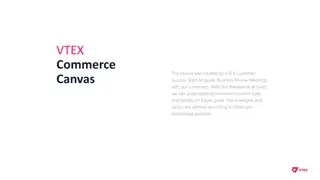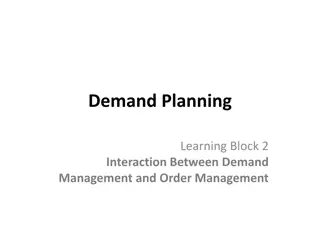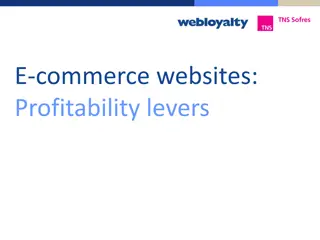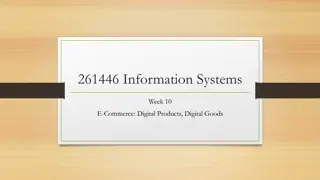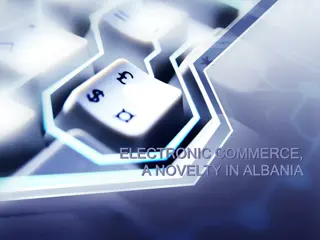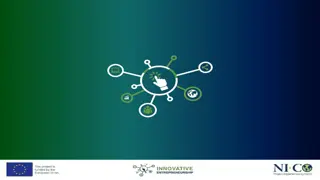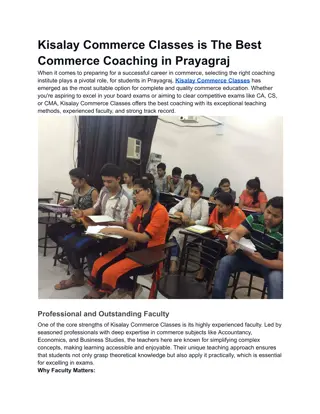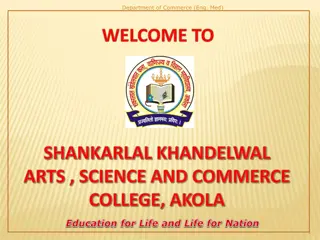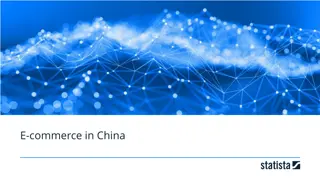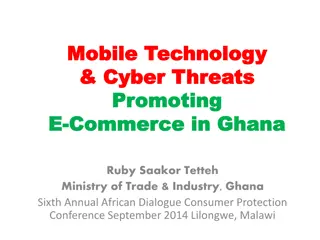Understanding E-Commerce: History, Features, and Types Explained
E-commerce, or electronic marketing, involves buying and selling goods and services online. The history of e-commerce traces back to the 1970s with Electronic Funds Transfer (EFT) and has evolved significantly since. Features like ubiquity, global reach, and interactivity define e-commerce. Different types include Business-to-Business (B2B) and Business-to-Consumer (B2C) models, each serving distinct purposes in online trade.
Download Presentation

Please find below an Image/Link to download the presentation.
The content on the website is provided AS IS for your information and personal use only. It may not be sold, licensed, or shared on other websites without obtaining consent from the author. Download presentation by click this link. If you encounter any issues during the download, it is possible that the publisher has removed the file from their server.
E N D
Presentation Transcript
Prof. Anil Khadse NKTT College Prof. Anil O. Khadse NKTT
WHATIS E- COMMERCE Commonly known as Electronic Marketing. It consist of buying and selling goods and services over an electronic systems Such as the internet and other computer networks. E-commerce is the purchasing, selling and exchanging goods computer networks (internet) through which transaction or terms of sale are performed Electronically. and services over Prof. Anil O. Khadse NKTT
Brief History Of E-Commerce Prof. Anil O. Khadse NKTT Prof. Anil Khadse
1970s: Electronic Funds Transfer (EFT) Used by the banking industry to exchange account information over secured networks Late 1970s and early 1980s: Electronic Data Interchange (EDI) for e-commerce within companies Used by businesses to transmit data from one business to another 1990s: the World Wide Web on the Internet provides easy-to-use technology for information publishing and dissemination Cheaper to do business (economies of scale) Enable diverse business activities (economies of scope Prof. Anil O. Khadse NKTT
Features of E-Commerce Ubiquity Global reach Universal standard Richness Interactivity Information Density personalization Prof. Anil O. Khadse NKTT
TYPES OF E-COMMERCE Prof. Anil O. Khadse NKTT
BUSINESS-TO-BUSINESS (B2B) B2B stands for Business to Business. It consists of largest form of Ecommerce. This model defines that Buyer and seller are two different entities. It is similar to manufacturer issuing goods to the retailer or wholesaler. E.g.:-shop2gether.com Prof. Anil O. Khadse NKTT Prof. Anil Khadse
BUSINESS-TO-CONSUMER (B2C): It is the model taking businesses and consumers interaction. The basic concept of this model is to sell the product online to the consumers. B2C is the direct trade between the company and consumers. It provides direct selling through online. For example: if you want to sell goods and services to customer so that anybody can purchase any products directly from supplier s website. e.g amazon.com Prof. Anil O. Khadse NKTT
CONSUMER-TO-CONSUMER (C2C) There are many sites offering free classifieds, auctions, and forums where individuals can buy and sell thanks to online payment systems like PayPal where people can send and receive money online with ease. e.g: ebay.com Prof. Anil O. Khadse NKTT
ADVANTAGESOFE-COMMERCE It facilitate to assess information of any products without any restriction. Remain open for all the time national and international customers i.e Availability of 24x7 Enables smaller companies to compete with larger companies Reduces in staffing and/or high street stores thereby reducing costs There is no limitation on geographical boundaries for doing business. 10 Prof. Anil O. Khadse NKTT
ADVANTAGESOFE-COMMERCE It reduces the cost of marketing and distribution and travel time. It facilitate comparison shopping. E-Commerce boost the possibilities for performing direct marketing. It is very convenient way of shopping for old age people. 11 Prof. Anil O. Khadse NKTT
LIMITATIONSOF E-COMMERCE Product not bought online Security System and data integrity Expensive to maintain a scalable website Fulfillment problem Corporate vulnerability Technological Limitation 12 Prof. Anil O. Khadse NKTT
BUSINESSMODELINE-COMMERCE Advertising Revenue Model Subscription Revenue Model Transaction Fee Revenue Model Sales Revenue Model Affiliate Revenue Model 13 Prof. Anil O. Khadse NKTT
MAJORB2C MODELS 14 Prof. Anil O. Khadse NKTT
B2C E-COMMERCETRANSACTIONS VISA credit card is charged Order placed by user Shopping cart Order form Order is competed Shipping carrier picks up shipment Prof. Anil O. Khadse NKTT E-mail is sent to customer to merchant Sent to warehouse
MAJOR (B2C) BUSINESS MODELS 1. Portal 2. E-Tailer 3. Content Provider 4. Transaction Broker 5. Service Provider 6. Market Creator 7. Community provider Prof. Anil Khadse
MAJOR B2C BUSINESS MODELS Business Model Description Portals are gateways to the Internet Offers powerful Web searching tools- effiency and ease The portal business model is in addition to serving as a gateway to the Internet; It is a destination site provide an integrated package of content and services all in one place Portal Prof. Anil Khadse
B2C BUSINESS MODELS: PORTAL An integrated package of content like News weather forecasts currency rates stock quotes phone and map information Services like Entertainment Chat Game Downloads Shopping-auction E-card Sms service search
Example Description Business Model Yahoo.com msn.com Offers an integrated package of services and content such as search,e-mail,chat etc. Seeks to be a user s home base. iBoats.com Offers services and products to specialized market place. A gateway information particular industry, such as human resources, health care, insurance, automobiles, or food manufacturing. or related portal to a Portal to
Business Model Example Description Amazon.com, ebooks.com Online version of retail store where customers can shop 24/7 with comfort. Walmart.com, bestbuy.com Online company that also has physical stores. distributor channel for LandsEnd.com, llbean.com Online version of direct catalog. The catalog merchant has generally lower prices than other retailers and lower overhead expenses due to the smaller size of store and lack of large showroom space. Online version of mall. E-tailer Fashionmall.com internetmall.com Dell.com, unionway.com Online manufacturers. sales made directly by Prof. Anil Khadse
MAJOR B2C BUSINESS MODELS Business Model Example Description Information and entertainment providers like newspapers, sports sites or other offering up-to-date (news, special interest , photos, video, artwork etc) to customers. Infomediaries: electronicintermediariesthat controlinformationflowin cyberspace, oftenaggregating informationandsellingitto others They do not own but aggregate and distribute the content produced by others online sources information Sportsline.com, Timesofindia.com expressindia.com Content Provider Prof. Anil Khadse
Business Model Example Description Google maps Gmail Companies make money by selling users a service, rather than a product. Offers online, consultancy, knowledge, etc. Eg. Window updates offered by Microsoft that services like trade expertise SERVICE PROVIDER Prof. Anil Khadse
TRANSACTIONBROKER Processors of online sales transactions, such as stock brokers and travel agents that increase customer `s productivity by helping them do things faster. It assists buyers, sellers, transaction and acts as an agent for larger markets. Furthermore, they sell others products rather than their own product. Transaction brokers receive commissions for every transaction that had been successfully concluded in order to sustain their business. One legal advantage to sellers is that the seller is usually not legally responsible for the actions of transaction brokers acting within the scope of the transaction. or both during Prof. Anil Khadse
Business Model Community Provider Example Description About.com, iVillage.com Sites where individuals with particular interests, hobbies and common experience can come together and compare. Communities utilize electronic tools such as forums, chat rooms, e-mail lists, message boards, and other interactive Internet mechanisms, which are usually tailored to the particular community. Prof. Anil Khadse
Business Model Example Description eBay.com, Priceline.com, upperbid.com Web-based that technology markets buyers together. The success factor is: ->Attracting critical number of sellers and buyers marketplace. ->Speed, become quickly Prof. Anil Khadse businesses internet to create that and use bring sellers MARKET CREATOR sufficient to the ability operational to
E-COMMERCESECURITY 26 Prof. Anil Khadse
Q. Discuss various security issues in E- Commerce Integrity Non-repudiation Authenticity Confidentiality Availability 27 Prof. Anil Khadse
ENCRYPTION: Encryption messages from being read by anyone It transform message and data to protect their meaning. Encryption means converting the plain / readable text into code i.e Chiper text. means protecting internet 28 Prof. Anil Khadse
WHATIS CRYPTOGRAPHY? Cryptography derived its name from a Greek word called Kryptos which means HiddenSecrets . Cryptography is the practice and study of hiding information. It is the Art or Science of converting a plain intelligible data into an unintelligible data retransforming that message into its original form. and again It provides Confidentiality, Integrity, Accuracy. Prof. Anil O. Khadse NKTT Prof. Anil Khadse
WHATIS ENCRYPTION / DECRYPTION Encryption : Encryption means converting the plain / readable text into code i.e Chiper text. Encryption means protecting internet messages from being read by anyone It transform message and data to protect their meaning. Chiper Text Encryption using Key Plain Text Prof. Anil O. Khadse NKTT
Decryption The process of converting cipher text into a plain text is called Decryption. Decryption using Key Plain Text Chiper Text 31 Prof. Anil O. Khadse NKTT
WHATARETHE TYPESOF CRYPTOGRAPHY Symmetric Key Cryptography (Secret Key Cryptography) Same Key is used by both parties Advantages 1. Simpler and Faster Disadvantages 1. Less Secured Image taken from :- www.google.com Prof. Anil O. Khadse NKTT Prof. Anil Khadse
Private Key Public Keys Prof. Anil O. Khadse NKTT Prof. Anil Khadse
WHATIS SECURE SOCKET LAYER ? Secure Socket Layer (SSL) is a protocol developed by Netscape for transmitting private documents via the Internet. The SSL Security protocol provides data encryption, server message integrity, and optional client authentication for a TCP/IP connection. SSL is built into all major browsers and web servers. Use HTTPS instead of HTTP authentication, Prof. Anil O. Khadse NKTT
WHATIS SSL? (CONTD) Both Netscape Navigator and Internet Explorer support SSL, and many websites use the protocol to obtain confidential user information, such as credit card numbers. The primary goal of SSL is to provide privacy and reliability between two communicating applications. 35 Prof. Anil O. Khadse NKTT
SECURE ELECTRONICTRANSACTION SET is developed by an association led by Mastercard and Visa It is protocol designed for handling credit Card transactions over the Internet It ensures the identities of all parties involved in the transaction. It also encrypts Credit Card and transaction information before transmitting on the internet. 36 Prof. Anil Khadse
PAYMENTSYSTEM Digital Cash Online Stored Value PayPal Smart Card o Digital Accumulating Balance Payment o Digital Cheque Payment System 37 Prof. Anil O. Khadse NKTT
